
Aioli, allioli or aïoli is a cold sauce consisting of an emulsion of garlic and olive oil; it is found in the cuisines of the northwest Mediterranean, from Andalusia to Calabria.

A tunicate is a marine invertebrate animal, a member of the subphylum Tunicata. It is part of the Chordata, a phylum which includes all animals with dorsal nerve cords and notochords. The subphylum was at one time called Urochordata, and the term urochordates is still sometimes used for these animals. They are the only chordates that have lost their myomeric segmentation, with the possible exception of the 'seriation of the gill slits'. However, doliolids still display segmentation of the muscle bands.

Carpobrotus edulis is a ground-creeping plant with succulent leaves in the genus Carpobrotus, native to South Africa. Its common names include hottentot-fig, sour fig, ice plant or highway ice plant.

Ascidiacea, commonly known as the ascidians or sea squirts, is a paraphyletic class in the subphylum Tunicata of sac-like marine invertebrate filter feeders. Ascidians are characterized by a tough outer "tunic" made of a polysaccharide.

A garnish is an item or substance used as a decoration or embellishment accompanying a prepared food dish or drink. In many cases, it may give added or contrasting flavor. Some garnishes are selected mainly to augment the visual impact of the plate, while others are selected specifically for the flavor they may impart. This is in contrast to a condiment, a prepared sauce added to another food item primarily for its flavor. A food item which is served with garnish may be described as being garni, the French term for "garnished."

Valencian cuisine is a Mediterranean cuisine as cooked in the Valencian Community, Spain. Its basic ingredients are vegetables, seafood and meat. It is famous worldwide for its rices, such as paella, and its citrus fruits. The cuisine of neighbouring regions have given and received important contributions from Valencian gastronomy, amongst them Balearic cuisine, Catalan cuisine, Aragonese cuisine, Manchego cuisine and Murcian cuisine.

A buñuelo is a fried dough fritter found in Spain, Latin America, and other regions with a historical connection to Spaniards, including Southwest Europe, the Balkans, Anatolia, and other parts of Asia and North Africa. Buñuelos are traditionally prepared at Christmas. It will usually have a filling or a topping. In Mexican cuisine, it is often served with a syrup made with piloncillo.

Carpobrotus, commonly known as pigface, ice plant, sour fig, Hottentot fig, and clawberry is a genus of ground-creeping plants with succulent leaves and large daisy-like flowers. The name comes from the Ancient Greek karpos "fruit" and brotos "edible", referring to its edible fruits.

Sephardic Jewish cuisine is an assortment of cooking traditions that developed among the Sephardi Jews.
Culinary names, menu names, or kitchen names are names of foods used in the preparation or selling of food, as opposed to their names in agriculture or in scientific nomenclature. The menu name may even be different from the kitchen name. For example, from the 19th until the mid-20th century, many restaurant menus were written in French and not in the local language.

Tunisian cuisine, the cuisine of Tunisia, consists of the cooking traditions, ingredients, recipes and techniques developed in Tunisia since antiquity. It is mainly a blend of Mediterranean and native Punics-Berber cuisine. Historically, Tunisian cuisine influenced many cultures and nations like Italians, Andalusians, French and Arabs.

Ecteinascidia turbinata, commonly known as the mangrove tunicate, is a species of sea squirt species in the family Perophoridae. It was described to science in 1880 by William Abbott Herdman. The cancer drug trabectedin is isolated from E. turbinata.

Pyura chilensis, called piure in Spanish and piür or piwü in Mapudungun, is a tunicate of the family Pyuridae. It was described in 1782 by Juan Ignacio Molina.

Carpobrotus aequilaterus, common names: angled pigface, Chilean pigface, This species is thought to have originated in southern Africa and a naturalised weed elsewhere. However, according to VicFlora it is native to South Africa, It is also known as the sea fig.

Burmese salads are a diverse category of indigenous salads in Burmese cuisine. Burmese salads are made of cooked and raw ingredients that are mixed by hand to combine and balance a wide-ranging array of flavors and textures. Burmese salads are eaten as standalone snacks, as side dishes paired with Burmese curries, and as entrees. The iconic laphet thoke is traditionally eaten as a palate cleanser at the end of a meal.
Stolonica socialis is a species of tunicate or sea squirt in the family Styelidae, commonly known as orange sea grapes. It is native to the northeastern Atlantic Ocean, where it lives on the rocky seabed in shallow water.

Menorcan cuisine refers to the typical food and drink of Menorca.

Pyura haustor is a species of sessile ascidian, or sea squirt, that lives in coastal waters in the north-eastern Pacific Ocean, attached to rocks or artificial structures. Common names for this species include the wrinkled seapump, the wrinkled sea squirt and the warty tunicate.

Paparajotes are a typical dessert of Murcia, Spain made with lemon leaves coated with a dough made with flour and egg that are fried and sprinkled with powdered sugar and cinnamon.

Ma'qūda is a Maghrebi fritter made of a potato-based batter. In addition to puréed potato, the batter can contain garlic, salt, hot pepper, egg, and cheese.





















